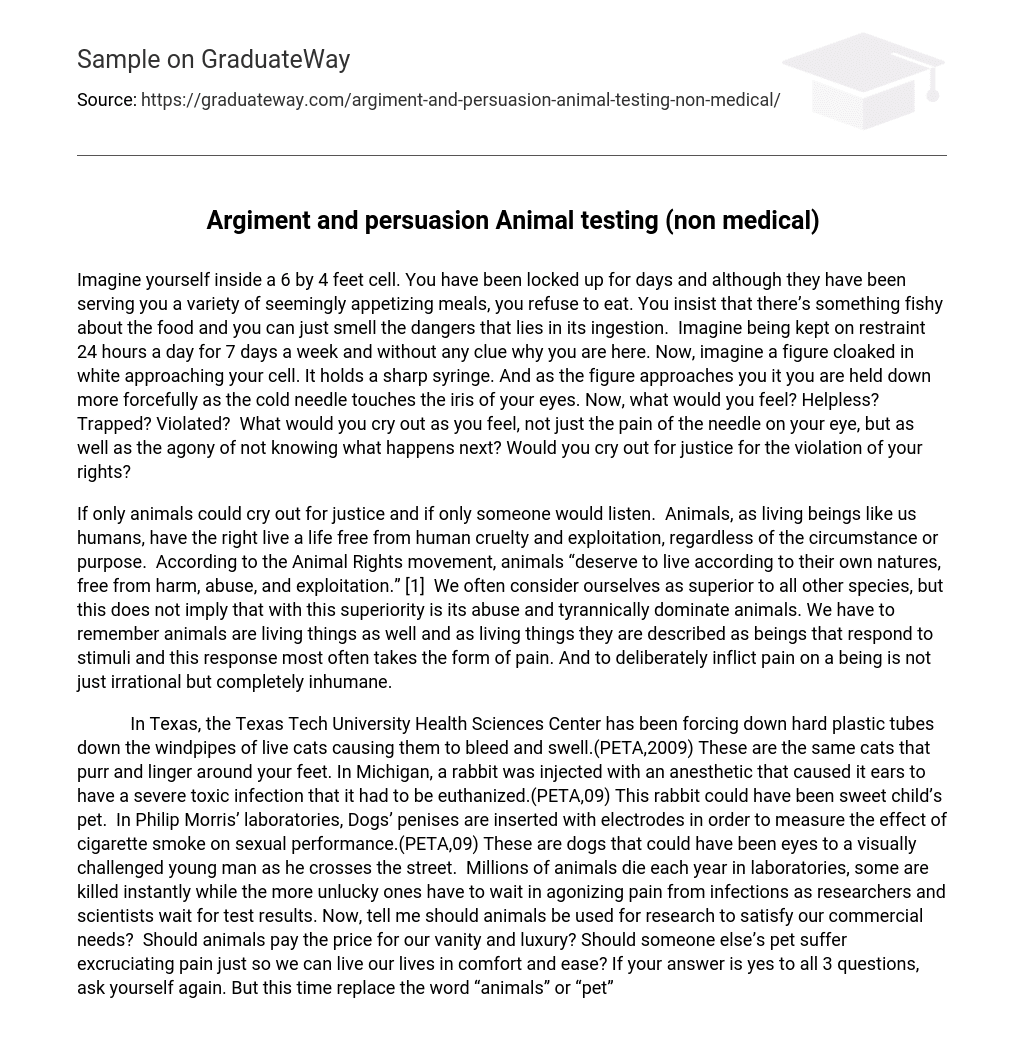Imagine yourself inside a 6 by 4 feet cell. You have been locked up for days and although they have been serving you a variety of seemingly appetizing meals, you refuse to eat. You insist that there’s something fishy about the food and you can just smell the dangers that lies in its ingestion. Imagine being kept on restraint 24 hours a day for 7 days a week and without any clue why you are here. Now, imagine a figure cloaked in white approaching your cell. It holds a sharp syringe. And as the figure approaches you it you are held down more forcefully as the cold needle touches the iris of your eyes. Now, what would you feel? Helpless? Trapped? Violated? What would you cry out as you feel, not just the pain of the needle on your eye, but as well as the agony of not knowing what happens next? Would you cry out for justice for the violation of your rights?
If only animals could cry out for justice and if only someone would listen. Animals, as living beings like us humans, have the right live a life free from human cruelty and exploitation, regardless of the circumstance or purpose. According to the Animal Rights movement, animals “deserve to live according to their own natures, free from harm, abuse, and exploitation.” [1] We often consider ourselves as superior to all other species, but this does not imply that with this superiority is its abuse and tyrannically dominate animals. We have to remember animals are living things as well and as living things they are described as beings that respond to stimuli and this response most often takes the form of pain. And to deliberately inflict pain on a being is not just irrational but completely inhumane.
In Texas, the Texas Tech University Health Sciences Center has been forcing down hard plastic tubes down the windpipes of live cats causing them to bleed and swell.(PETA,2009) These are the same cats that purr and linger around your feet. In Michigan, a rabbit was injected with an anesthetic that caused it ears to have a severe toxic infection that it had to be euthanized.(PETA,09) This rabbit could have been sweet child’s pet. In Philip Morris’ laboratories, Dogs’ penises are inserted with electrodes in order to measure the effect of cigarette smoke on sexual performance.(PETA,09) These are dogs that could have been eyes to a visually challenged young man as he crosses the street. Millions of animals die each year in laboratories, some are killed instantly while the more unlucky ones have to wait in agonizing pain from infections as researchers and scientists wait for test results. Now, tell me should animals be used for research to satisfy our commercial needs? Should animals pay the price for our vanity and luxury? Should someone else’s pet suffer excruciating pain just so we can live our lives in comfort and ease? If your answer is yes to all 3 questions, ask yourself again. But this time replace the word “animals” or “pet” with a name, the name of your mother, classmate, brother, or friend. Would you still say yes?
There are laws which try to protect an animal from cruelty. Act to Prohibit Animal Testing for Cosmetic Manufacturing is one example of such law. According to this act “manufacturers and to require manufacturers to adopt non-animal testing methods in order to end the cruelty to animals” (Singer, 86) These non-animal methods have already been developed and can obtain the same results as with the use of animals. Cell culture, human-based testing and computer stimulation are just some of these tests that are already readily available to researchers and scientists. Pharmagene cofounder, Gordon Baxter once said, “If you have information on human genes, what’s the point of going back to animals?”(Coghlan, 96) The use of stem cell research, CT scans and MIRs are just as effective and accurate when it comes to toxicology tests. In fact, they are faster than animal testing since results are almost instantly observable. These kinds of testing are argued to be more expensive that picking up a stray cat and doing all sorts of experiments on them. But the rebuttal to this is, with the billions of dollars these manufacturers get from consumer products what is a few millions to spend in order to protect life, wouldn’t they pay more to preserve their own?
Works Cited Page:
- PETA. “The Facts.” SmokingAnimals.com. 21 June 2004. Smoking Animals. 02 May 2009 <http://www.smokinganimals.com/facts.html>.
- PETA. “Product Testing: Toxic & Tragic.”
- PETA Media Center 02 May 2009 FactSheets. 02 May 2009 <http://www.peta.org/mc/factsheet_display.asp?ID=91>.
- PETA. ” Live Cats Used in Cruel Training Courses at Texas Tech.”
- PETA Action Center 02 May 2009 Action Alert 02 May 2009 < http://getactive.peta.org/campaign/texas_tech>
- PETA. ” Animals Suffer and Die in University of Michigan Laboratories.”
- PETA Action Center 02 May 2009 Action Alert 02 May 2009 < http://getactive.peta.org/campaign/university_michigan>
- Regan, Tom. The Case for Animal Rights. University of California Press: Berkeley, California , 1985.
- Singer , Peter. In Defense of Animals. HarperCollins Publishers: New York, NY, 1986
- Singer, Peter. Animal Liberation (Reprint). Ecco Publishers: New York, NY, 2001
- Coghlan, Andy. “Pioneers Cut Out Animal Experiments.” New Scientist, 31 Aug. 1996.





